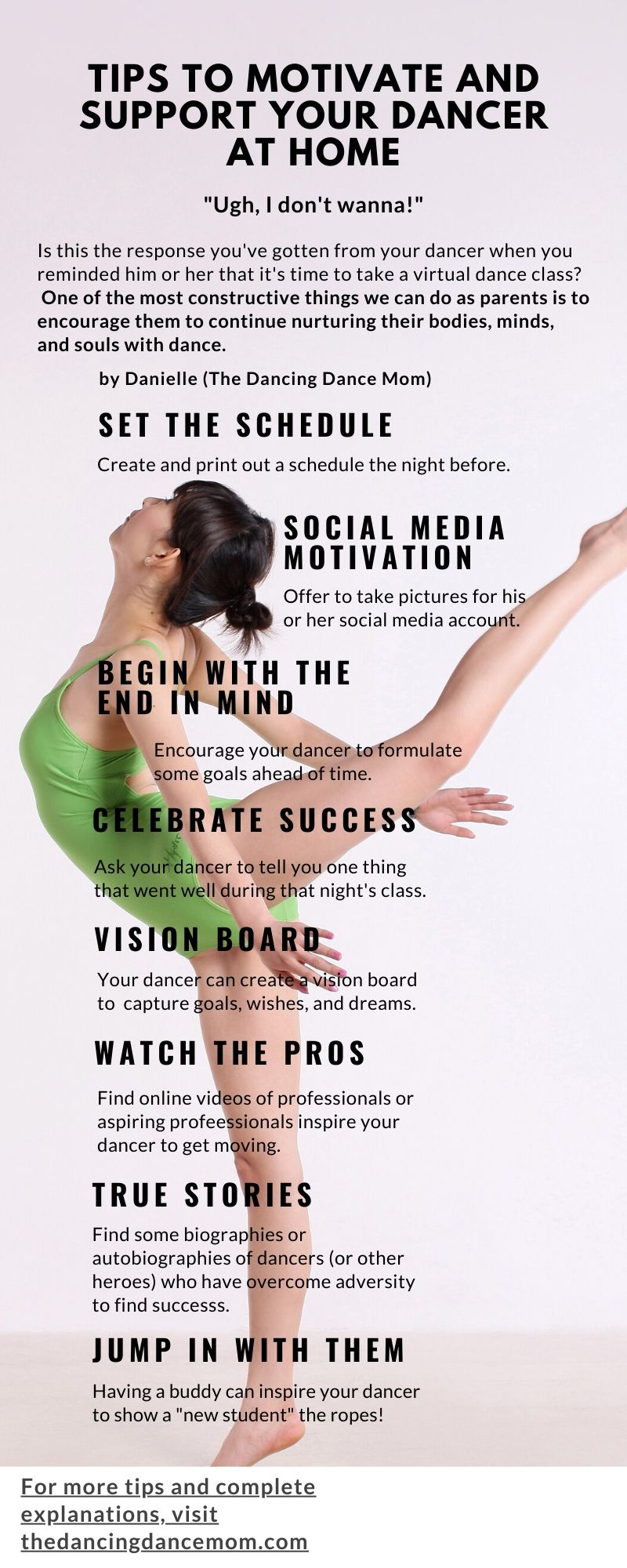
10 Tips to Motivate and Support Your Dancer At Home
“Ugh, I don’t wanna…”
Is this the response you’ve gotten from your dancer when you reminded him or her that it’s time to take a virtual dance class? If so, you’re not alone. So much about the quarantine situation has left kids (and adults) feeling helpless, alone, and unmotivated. An activity that they were utterly passionate about just a month or so ago can feel like an unwanted burden to them now. But one of the most constructive things we can do as parents is to encourage them to continue nurturing their bodies, minds, and souls with dance. In most cases, that’s a lot easier said than done. Knowing when to push and when to pull back can be a difficult balancing act for a parent, but it’s our job to make an effort to keep them connected and engaged.
#1 Set the schedule (and print it out)
The night before, create and print a schedule of the next day’s activities (including dance classes). Hang it up in or near your home’s “hub,” like the fridge, next to a large calendar, a cork board, etc. Make sure it is on display first thing in the morning (or better yet, the night before). Older children can be given the responsibility of creating their own calendar themselves. We use Google Docs for this; I create it and share this with all stakeholders, and they can add their academic commitments as well.
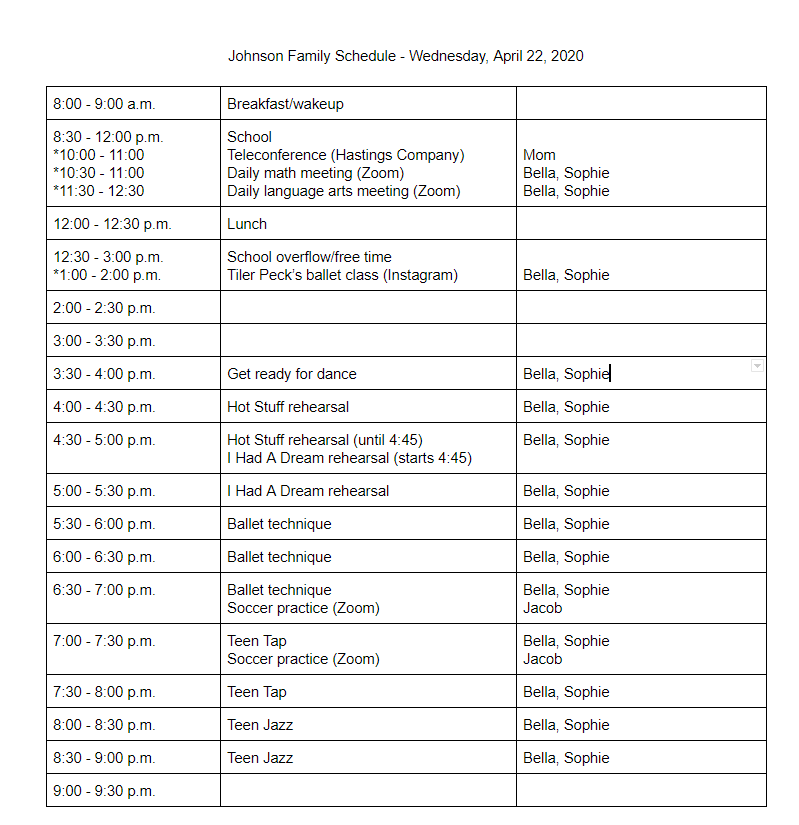
Why is this helpful? Setting the expectations earlier, rather than later, can help your children prepare themselves for their roles and responsibilities each day. If they planned to relax and play on the Xbox, but you come in with a harsh, frantic “You need to get ready! It’s time for ballet!” you will most not likely be met with unbridled enthusiasm (“Golly, thank you ever so much for reminding me! Gee whiz, I’m so lucky I have such a wonderful mother!”). Also, by pointing to the calendar when they protest, you’re taking a bit of the heat off of yourself (“Hey listen, it’s on the calendar. I don’t make the schedule”).
#2 Social media motivation

Does your tween or teen have an account with TikTok, Instagram, Snapchat, or one of those hip apps (I’m pretty sure by using the word “hip,” I have just proven that I am not)? Offer to take pictures during class to post and share with the studio and their dance friends. If they (and you) are really into it, you can do a bit of pre-planning and figure out what angle you’re going for (i.e., “Tilt Tuesday” or “Fouette Friday”). Suggest that they start a challenge with their friends for extra motivation!
#3 Begin with the end in mind
I’m borrowing a page from Stephen Covey’s book, 7 Habits of Highly Effective Teens here. As we would drive to the studio each afternoon, I’d ask my girls what their goals were for that day’s classes. If they said something like, “I want to get called out in ballet today,” I’d remind them that this particular goal is a bit out of their hands (their execution might be stellar, but the instructor might not address it for whatever reason), and encourage them to focus on something within their reach (“I’m going to use my turnout consistently during barre work today”). This exercise still holds value, even when the classes are virtual. Just remember to let your child formulate his or her goals (people, including kids, are much more likely to work towards an objective if it came from within themselves). After classes, you can initiate a gentle, low-pressure chat to have your dancer evaluate their success in achieving his/her goal. If your dancers do not want to discuss these goals with anyone, they can write them in a journal or dance notebook; this format also allows them to write a follow-up reflection after class. As long as these exchanges are kept casual and “light,” they can be constructive opportunities for growth.
#4 Celebrate success
At the end of each night, I would ask my girls to tell me something good that happened to them during their classes. Even though we’re home, we still follow this ritual. It helps them to focus on the positives, and gives them a chance to celebrate a personal triumph. They can’t wait to tell me about getting complimented on something they’ve worked hard on. Success begets success, so give them a place to share their accomplishments.
#5 Vision board
Creating a vision board can be a great motivator and creative outlet for your dancer. Vision boards encapsulate the maker’s dreams and wishes, and can serve as an attention-grabbing reminder of the goals that he or she has established (this article explains some of the science behind it). Pinterest is dripping with suggestions and examples for making a vision board! They can be neat and organized, or more of a freewheeling collage-style creation; they can include pictures of a movement they want to master, inspirational quotes, photos of personal heroes, etc. The possibilities are endless!
#6 Watch the pros
Do a little digging and find some online videos of professional dancers doing their thang (is “thang” still a “thing”?)! There are resources that provide free viewings of Broadway shows, ballet company performances, hip-hop crew routines, etc. Watching school dance team performances, virtual dance competitions, and even college team audition videos can also be very motivating!
#7 True stories

Countless dancers have had to overcome adversity to realize their dream, and their biographies and autobiographies are a rich source of inspiration. Most nights (after class and before bed), I would read a chapter or two from Michaela DePrince’s autobiography, Taking Flight. The girls and I had many amazing discussions about some great life lessons (one of our favorites is along the lines of: “Be thankful for the part you got, because there’s always someone else who would gladly take it”) and put our own problems in perspective when we compared ours with hers (she was an orphan from war-torn Sierra Leone). Misty Copeland also has a biography that comes in a young reader’s edition (my girls started it, but didn’t finish yet); the poise and grace she exhibits now were forged through the tough trials she faced while growing up. There are countless other well-known figures, both in and out of the dance world, that have inspiring stories that teach us about perseverance, determination, and grit, qualities that can help carry your dancer through this rough patch.
#8 Jump in with them
Yes, seriously. Having someone alongside them can be the X factor that gets them going. Potentially, it could help your dancer see the class in a whole new light as they watch you, a new student (for all intents and purposes), struggle to exhibit the mastery that he or she can easily showcase without breaking a sweat. Taking you under his or her wing may give your dancer a renewed sense of purpose. In some cases, it could provide a much-needed source of comic relief (no offense to any of you; I lump myself into this category). If it’s a Zoom class or Google Meet where your dancer is on video, you may have to find a cozy corner to follow along so you’re not in the “shot” (which would obviously distract the teacher and other students). Or you could take it a step further and suggest a “bring a parent/sibling” virtual class to the studio owner so other families can join in the fun!
#9 Dear me (in ten years) letter
Encourage your dancer to write a letter to the +10 year version of himself/herself. Laying out the fears, hesitations, worries, and anxieties that are plaguing them, children can find this to be a very cathartic experience. This is also a useful way to write down goals, hopes, desires, and dreams, and get them thinking seriously about how they can pave the path to the future they want.
#10 Phone a friend
I may be showing my age with this Who Wants to Be a Millionaire? reference, but oh well…If all else fails, you may consider reaching out to the studio owner or a trusted teacher. Chances are, your dancer is not the only one struggling with this difficulty, so the professional may have a few tricks up the sleeve to pull the lost lambs back into the fold. They may even offer to call your dancer to offer some words of praise, understanding, and encouragement, making your dancer feel more connected to the studio and beholden to his/her teammates.
The bottom line…
Obviously, you know your child better than anyone else. Take your cues from your kids to know when to keep up with the gentle prodding and when to turn down the intensity of your involvement. This is NOT the time to play the heavy; our children are victims of the coronavirus plague, whether they are infected or not. They have had to make unprecedented sacrifices, as have we all, and may feel powerless, angry, and confused. Give them (and yourself) some grace, and keep the bonds of family strong.
This post contains affiliate links. We may earn compensation when you click on the links at no additional cost to you.
Work hard, have fun! – Danielle
What other suggestions do you have for parents of reluctant at-home dancers? Post your comments below!
Mind your manners! Remind your dancers that, even virtually, they are expected to mind their p’s and q’s, and read Virtual Dance Class Etiquette.
You May Also Like
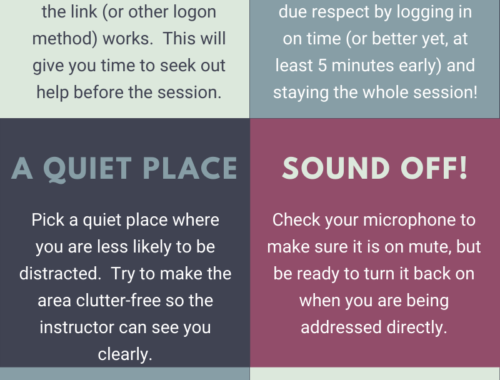
Virtual Dance Class Etiquette
May 13, 2020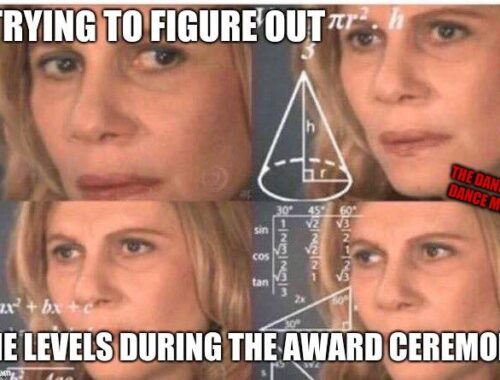
Diamond, Platinum, 5-Stars, Oh My!
July 2, 2020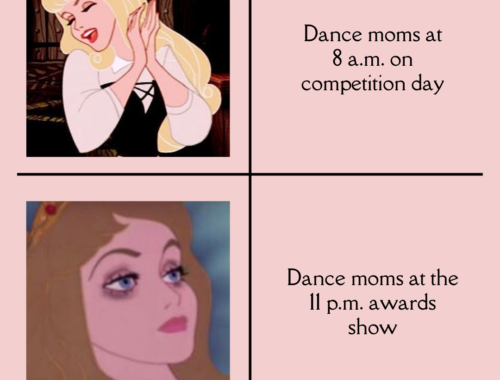



44 Comments
Ghulam Mohyudin
It was perfect the first time. I learn so much from you as well! Keep it up great post.
Danielle
Thank you so much!!! I’m glad you find value in these.
Santana
I really think seeing a schedule is key!
Crystal
Such great advise!
Danielle
Thank you!
Tricia Snow
I like how you want to keep it fun and light. I think that is important.
Danielle
Thank you! The kids are going through enough right now – now isn’t the time for a heavy-handed approach (at least, that’s my experience).
Douglas Jasper
I can’t believe the effort required for competitive dance. Our niece competed in Orlando 2 years ago and I know how much time she puts in training.
Danielle
It is an investment of time, money, blood, sweat, and tears (mostly about the money, lol).
Holly
I agree right now and always we should never push our children in a zone of anxiety. Their emotional wellbeing is the most important thing!
Lisa Manderino
I like setting a visual schedule too! They are amazing to dance so much during quarantine, it is hard to not be in a studio!
Debbie
Good advice. I remember buying new dance outfits as bribes. Lol
Danielle
I’ve got to remember that one, lol! Although they have so many already outfits already, I don’t know where we’d put them 😉
Kirsten
Your first line is our house exactly! My two girls are taking their dance classes virtually and the younger one complains constantly. These are really great tips, thanks!
Danielle
You’re welcome! I hope things get better soon!
Linda Egeler
These shelter-at-home days are tough in so many ways. I feel for your girls. I have attended a cardio dance class three times a week for almost 10 years now. It is pure joy and great stress relief. I find I must force myself to keep up with it now: following along on Zoom while in my living room is simply not the same. I miss the social connection. Kudos to you and your dancers for persevering!
Danielle
I know what you mean; I miss my in-person Zumba and Vixen classes. Thank you!
ANgela
My theater daughter is not a fan of this SIP stuff, most of the kids had zero motivation to do stuff via zoom. It is a hard time and I appreciated this post.
Danielle
I’m sorry she’s having a hard time. I hope things get better soon!
Lee Anne
Having it printed out and ready first thing in the morning is an excellent idea. Looks like a lot of fun, but hard work!
Danielle
I use Google Docs, so I just make a copy of the same day last week (there’s little, if any, change with the class schedule). It doesn’t take too long, and it saves us a bit of frustration from scrambling through emails and messages to look up the schedule. It’s a little piece of the storm that I can actually control, lol.
Lisa Maslyk
Hopefully we get back to some sort of real life again soon, thanks for sharing your awesome ideas!
Sara - Seek Discover Learn
I love your suggestion of having them read about other dancers who have overcome adversity. I think it’s so important for kids to have role models that they can relate to and gain inspiration from.
Suzan | It's My Sustainable Life
Love your idea for getting inspiration from the pro’s!
Danielle
Thanks!
Eva Keller
I don’t know a single child that wouldn’t be motivated by all of the above. I know it would’ve motivated me! Great post!
Danielle
Thanks so much!
Heather Jandrue
Wow, that is a lot of dance! I love the committment.
Jen
We’ve had to apply many of these same tips to our runner boys! Some days they’re motivated; others they’re not. We’ve also tried to just let them enjoy being kids, riding bikes and playing in the woods. Keep it up momma!
Kendra
Sometimes I miss this….and other times it’s so freeing not to have this schedule all the time. LOL
Ruth Iaela-Pukahi
Wow that is a tight schedule! When do they get to eat? lol, I’m sure they eat but when there is a dream, you have to pay the price. They are lucky to have your support for their big dreams!
Danielle
Thank you!
Charlene
My daughter misses dance so much! She was getting ready to perform when everything shut down. I’m just curious, though… how do you do soccer on Zoom??
Danielle
My son’s coach has them run through some drills together. The kids each have their ball and four cones (or other markers), and they do some footwork and agility exercises.
So heartbreaking about dance. With them being inside (and everyone being in close quarters), it would not surprise me if competitions were among the last activities to start back up.
Sandi
It’s so good to see downtime in the schedule. With everyone home, we forget to just relax a bit
Danielle
I feel like, now more than ever, we need that balance of productive time and downtime. Thanks for weighing in!
Tonya | the Writer Mom
I was never in dance, but I was in piano lessons as a kid, and I remember how hard it was to get motivated and practice. Great tips!
Katherine Wolfe
All of these virtual classes are crazy to me! Not in a bad way….it’s great that people have come up with creative ways to continue activities right now. I just mean in a “I think I would giggle the whole time too” way!
Danielle
I did a workout via Zoom, and it was a little strange. I did feel like giggling, and seeing myself was definitely an odd experience. Thanks for weighing in!
Tiffany
Motivation has been hard these last few months – but these are some great ways to make it all happen!
Danielle
Thank you!
Cindy
The schedule is a great idea! And wow, it is a very full schedule! Is every day like that?
Danielle
We have a couple of days each week where we have little or no extracurricular activities. My girls do have a class Zoom meeting every day (at least one), but the dance fluctuates. Thanks for commenting!
Melissa Jones
I love vision boards!